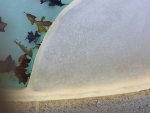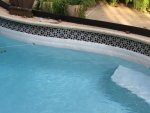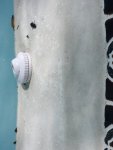Adding CO2 converts hydroxide alkalinity into bicarbonate alkalinity.
CO2 + OH --> HCO3
So, carbon dioxide is not responsible for increasing the total alkalinity.
For the total alkalinity to increase, something alkaline needs to be added.
If a sodium hypochlorite solution has excess lye (hydroxide), it will raise pH and TA. It's the hydroxide that raises the total alkalinity.
Adding CO2 to lower the pH converts hydroxide alkalinity into bicarbonate alkalinity.
To lower pH rise caused by something other than CO2 loss, hydrochloric acid should be used.
H + OH --> H2O
When CO2 is lost, pH rises with no change in TA.
HCO3 + H --> H2O + CO2
So, the injection of CO2 is the reverse of aeration. You're just forcing CO2 into the water instead of forcing it out.
CO2 + H2O --> HCO3 + H
So, bicarbonate is created, which increases the alkalinity but a hydrogen ion is also created, which lowers the pH and alkalinity for a net change in the total alkalinity of zero.
If pH rise is only due to carbon dioxide loss, reinjecting the carbon dioxide brings you back to where you were before the carbon dioxide was lost.
If the carbon dioxide is injected at the same rate as it's lost, the pH and TA remain stable.
The problem is that CO2 is expensive and you have to keep reinjecting it to replace what offgasses into the air.
Adding CO2 converts hydroxide alkalinity into bicarbonate alkalinity.
CO2 + OH --> HCO3
So, carbon dioxide is not responsible for increasing the total alkalinity.
For the total alkalinity to increase, something alkaline needs to be added.
If a sodium hypochlorite solution has excess lye (hydroxide), it will raise pH and TA. It's the hydroxide that raises the total alkalinity.
Adding CO2 to lower the pH converts hydroxide alkalinity into bicarbonate alkalinity.
To lower pH rise caused by something other than CO2 loss, hydrochloric acid should be used.
H + OH --> H2O
When CO2 is lost, pH rises with no change in TA.
HCO3 + H --> H2O + CO2
So, the injection of CO2 is the reverse of aeration. You're just forcing CO2 into the water instead of forcing it out.
CO2 + H2O --> HCO3 + H
So, bicarbonate is created, which increases the alkalinity but a hydrogen ion is also created, which lowers the pH and alkalinity for a net change in the total alkalinity of zero.
If pH rise is only due to carbon dioxide loss, reinjecting the carbon dioxide brings you back to where you were before the carbon dioxide was lost.
If the carbon dioxide is injected at the same rate as it's lost, the pH and TA remain stable.
The problem is that CO2 is expensive and you have to keep reinjecting it to replace what offgasses into the air.
James W,
I noticed this discussion about CO2 vs. acid, perhaps you can help on an issue with my 15,000 gallon gunite/plaster pool I had built in 1981 in Atlanta, no automation, DE filter, using tri-chlor tabs. I had it replastered Oct 31, 2016, followed NPC start up procedure, and by end of December 2016 chemistry was balanced (FC4, CH 260, CYA 30, TA 120, pH 7.4, TDS 500) and appeared stable so it was closed . Reopened pool April 2017, chemistry way out of balance (FC 0, CH 380, CYA 30, TA 160, pH 8+, TDS 1000), crystals had formed on walls around pool perimeter. Plastering company sent representative of water chemical supplier who identified the crystals as calcium, added Blue Stuff, instructed me to run pump 24/7 and use stainless steel brush daily. Crystals were gone 3-4 weeks and have not reappeared.
Since then, now 2 years, the pH is still unstable and rises out of range 2-4 days, requiring frequent addition of acid to control, CH climbs to top end of range, as does CYA, water has been drained some and diluted several times to lower those levels. Even though the pH rises rapidly, the plaster is etching since the calcium crystals formed while closed Dec. 2016 - April 2017.
For a better understanding of the total water chemistry, I began using an LSI calculator when the new plaster was one year old in Oct. 2017. Through Dec 2018, 14 months, I have done 57 LSI calculations and 48 times the water was in the acceptable range of -0.3 to +0.3, 8 times it was out of range on the scale size >.3, only once on the etch side <.3. In some water tests the pH was over 8, but the test kit measures only to 8, so LSI was actually more on the + side than calculations show. In Oct 2018 I switched from tri-chlor to liquid chlorine to bring down the CYA, now at 50. I also added borates to prevent pH from rising which raised the TA from 120 to 160 but pH is stable at 8.1 to 8.2. I also started using a digital pH meter for accurate pH reading . During this cold weather period I have not tried to lower pH believing that scaling is a preferred condition vs. etching.
I have been told that even though the LSI is almost never on the etch side of the LSI scale, the etching is caused by the frequent addition of acid and that I should consider switching to CO2 injection to control pH without the corrosive effects of acid. No one has been able to explain why, over the 2 year and 4 month time period, the pH continues to rise or why the plaster is etching when it should be scaling. What do you think in going on with my pool and do you think CO2 injection is appropriate?
Thanks Richard
PS - I have a spread sheet of all water tests since replastering including chemical additions and water dilution.




